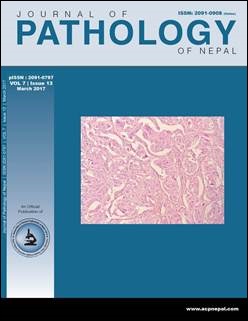Spectrum of histomorphological diagnosis in cystoscopic bladder biopsies
DOI:
https://doi.org/10.3126/jpn.v7i1.16913Keywords:
Cystitis, Eosinophilic, Papilloma, Urothelial carcinomaAbstract
Background: Urinary bladder lesions are the main source of significant clinical symptoms which are more disabling than lethal. Bladder tumors constitute one of the most common urological pathology. Urothelial carcinoma accounts for 90% of all primary tumors of the bladder. This study aimed to determine the frequency of different types of lesions of the urinary bladder and to determine the grade and stage of urothelial tumors.
Materials and Methods: This is a 2 years cross sectional study of cystoscopic biopsies carried out in the Department of Pathology, Medicare National Hospital and Research Centre, Kathmandu, Nepal.
Results: Out of 87 cases, 58 (66.67%) cases were neoplastic lesions and 29(33.33%) cases were non- neoplastic lesions. Majority of neoplastic lesions 96.55% were urothelial (transitional cell) tumors comprising predominantly of low grade papillary urothelial carcinoma 50.91%. Muscle invasion was seen only in high grade papillary urothelial carcinomas.
Conclusion: Among bladder tumors low grade papillary urothelial carcinoma is the most common.
Downloads
Downloads
Published
How to Cite
Issue
Section
License
This license enables reusers to distribute, remix, adapt, and build upon the material in any medium or format, so long as attribution is given to the creator. The license allows for commercial use.




